Key takeaways
Thirty-two participants gathered in May 2024 for this year’s Animal Advocacy Strategy Forum (AASF), an event designed for animal advocacy leaders to connect and strategize.
Among others, participants identified as prominent challenges skepticism from part of the public and from some key decision-makers about plant-based products, tactical issues in corporate outreach work, the movement's lack of coordination and its lack of focus on developing long-term theories of change.
As a result, five projects to address key challenges faced by the movement were launched, four of which were active as of September 2024 (one was on hold).
AASF participants were also surveyed on their opinions on the state of the animal advocacy movement and the directions it should take in the future. 29/32 participants responded to the survey.
State of the movement
- Respondents believed that the most significant problems for organizations in the movement were their lack of coordination and their funding situation (both diversity and total amount).
- The most commonly mentioned external threats facing the movement were: economic and political headwinds (9/29) and insufficient buy-in from the general public and funders (7/29).
Future direction
- Regarding resource allocation:
- Respondents believed that movement resources over the next five years should be primarily allocated to Asia (Mean allocation=33%) and ‘Western’ countries (32%, or 39% when including Eastern European countries)
- Hens, broilers, and farmed fish were the three animal groups that received the highest allocations (Mean allocations, respectively 18%, 15%, and 13%).
- Respondents prioritized targeting businesses (Mean allocation=32%), the movement itself (26%), and governments (25%) over the greater public (17%).
- When asked what types of work the movement should start and stop doing in the next five years, respondents said it should begin doing various movement-strengthening activities (17/29 respondents), and suggested specific actions to stop doing, of which the only recurring one was de-emphasizing veganism (6/29).
- Milestones the movement should attempt to achieve over the next five to ten years were most frequently Policy wins (17/57 milestones submitted) and Internal-facing milestones that concerned areas of improvement for the movement (17/57).
- A majority of respondents agreed that the following types of talent will be increasingly needed over the next five years: Government and policy and/or lobbying expertise, Management, Fundraising, Campaigning, and Expertise on the developing world or specific neglected but populous countries.
Introduction
About the Animal Advocacy Strategy Forum (AASF)
Since 2022, Rethink Priorities has organized the Animal Advocacy Strategy Forum[1], an annual event that gathers approximately thirty organizations in the effective animal advocacy community to connect and coordinate on strategy. The summaries of previous editions can be found here for 2022 (Duffy, 2023), and here for 2023 (Dullaghan, 2023).
Thirty-two advocates collectively representing 28 organizations participated in this year's conference, held in May 2024. These organizations were involved in various types of work (see Appendix 3) and regions. 26/32 participants were in senior leadership roles at the moment of the event (i.e., “(Co-)Founder”, “Executive”, “Director”, and “(Vice-)President” roles).
About this report
In this report, we first present the 2024 event itself and summarize its substance. We later present the results of our annual strategy survey of AASF attendees. Readers will gain a sense of where there is consensus among community leaders about the main opportunities and challenges it faces.
2024 Event Summary
Agenda overview
The 2024 agenda was informed by the event’s three goals, namely:
- “Sharing information, insights, and reflections about the state of the movement”
- “Building connections and trust among animal advocacy organization leaders”
- “Co-strategi[zing] on actionable progress for some identified challenges, opportunities and needs, including topics like movement-building”
Day 1 was meant to build connections, trust, and a common understanding of the state of the movement. The agenda included a structured networking session and several lightning talks.
The focus of Day 2 was identifying key challenges and opportunities for the movement and brainstorming solutions to address them. Participants were invited to take part in individual and collective (in small groups) reflection and brainstorming sessions, and to pitch solutions at the end of the day.
Finally, the agenda for Day 3 was centered on collaborating on initiatives to improve the movement. Participants were grouped based on their affinities with the solutions suggested on Day 2, and coordinated on concrete next steps.
Challenges identified
Participants joined thematic groups corresponding to their respective areas of expertise and were asked to identify the “two most important challenges facing the movement regarding [their] group topic”. The key challenges they identified, grouped thematically, included:
- Consumption and market change
- There is a lack of evidence base regarding the effectiveness of interventions and nutritional claims about plant-based diets.
- There is skepticism from some of the public and some key decision-makers about plant-based products.
- Corporate work
- There are several critical challenges facing corporate outreach, ranging from some tactical issues to external factors such as war, the economy, etc. are making it harder to put meat reduction demands on institutions.
- Movement building & support
- Despite a strong desire to coordinate, organizations struggle to do so because there are either too many or too few organizations, as well as conflicting strategic timelines and priorities.
- There are talent bottlenecks in the movement: attracting, cultivating, and retaining talent to sustainability fill hardest-to-hire roles (e.g., fundraising, management, negotiation, leadership, campaigning training).
- Policy and legislative change
- There is an imbalance between our organizational/ movement power and that of the opposition.
- It is difficult to make progress in hostile, unpredictable, and very fluid environments.
- Social/ cultural change & long-term strategy
- There is a lack of focus, both with time and funding, on developing long-term theories of change.
- The movement is still too associated with individual dietary change in a way that might impede building a mass movement.
- On-farm improvements / Producer outreach
- Producers’ definition of welfare is different than animal advocates’ definition.
- Companies progressing on animal welfare are outcompeted on price and market accessibility.
Proposing solutions
Participants were later asked to brainstorm, prioritize, and pitch solutions to the big group. Finally, they were asked to form working groups to work on initial action plans for the projects they chose from the list of those pitched to the big group. As a result, five projects were “launched” during the event—of these, four were still ongoing at the time of writing this report, and one was on hold.
Annual Strategy Survey Results
In this section, we discuss the results of a strategy-related survey that we distributed to 2024 AASF participants.
Purpose
The purpose of this survey is to serve as a resource for strategic discussions and decision-making within the movement, by offering insight into animal advocacy leaders’ beliefs regarding the current state of the movement and its ideal future directions.
Methodology
This survey was distributed to 2024 AASF participants on their first day of attendance—that is, before any strategy-related programming took place. The rationale behind this was to minimize the influence of the programmed activities and other participants themselves over one’s responses. 29/32 participants completed the full survey. Two participants were not able to join at the time the survey was distributed.
The survey included fourteen questions, with a section covering the state and needs of respondents’ organizations, and another section covering respondents’ opinion of the movement’s state and its needs. Two questions were only partially analyzed due to a technical issue that hampered the interpretation of some responses.
Note that the trends in respondents’ beliefs presented below were not evaluated for statistical significance, and might look different with a different and larger sample, or even a replication with the same sample.
A note on the sample
This survey’s respondents represented organizations skewing large, and (relatively) well-funded, compared to typical animal advocacy organizations.[2] Note that among survey participants, advocates close to the Effective Animal Advocacy movement are overrepresented. Those belonging to ‘meta’ organizations (i.e. that work to help advocates and animal advocacy organizations rather than animals directly) likely are as well. The results should be interpreted accordingly.
For a more representative survey of farmed animal advocacy organizations, please refer to the upcoming (2024 Q4) Farmed Animal Funders & Stray Dog Institute State of the Movement Report.
Results
We focus on drawing high-level results from the survey. If you are interested in the specifics, please refer to the Appendix.
Current state of the movement
Several questions in the survey addressed the current state of the movement.
Movement-level concerns
1. Internal problems
Respondents were asked to select up to three of the most significant problems in a list of commonly mentioned problems characterizing the organizations in the movement. The results showed that respondents are mostly concerned by organizations’ lack of coordination and their funding situation (in terms of both funding diversity and total allocation). Three of the five most selected options were funding-related:
- Insufficient coordination between organizations (41% of respondents)
- Excessively relying on a few major donors (41%)
- Scarcity of economic resources (38%)
- A generally lacking evidence base (35%)
- Animal welfare doesn’t sufficiently appeal to potential contributors (24%)
These themes recurred throughout the survey. See Appendix 6 for the full results.
2. External threats
Respondents also indicated what “[they thought was] the most pressing external threat facing the movement right now”. The long-form responses were grouped thematically. The three most mentioned types of threats were the following:
- Animal advocates are facing the consequences of wider economic and political environments that are detrimental to the movement (9/29 responses). Among those responses, four were related to hostile economic environments, four to hostile political environments, and one was relative to both.
- The movement is suffering from a lack of support (7/29). There is a lack of support/ attention from the public, partly due to problems affecting humans attracting more attention (5/7), and funders are providing only limited resources (2/7).
- The movement is facing staunch opposition from the animal agriculture industry (5/29) as well as concerning trends in animal farming and animal product consumption (5/29).
Organization-level constraints
1. Funding
When asked to rate, from one to five, the level of funding constraint faced by their organization, almost a third of respondents leaned towards “you are considering shrinking to avoid running out of money”. Conversely, almost a third of respondents declared their organizations had no or almost no funding constraints. Eleven respondents selected option 3, indicating neither a funding constraint nor financial ease.
Figure 1: Respondents’ perceived level of funding constraint at their organizations, as of May 2024.
2. Talent
Asked to rate the level of talent constraint faced by their organization from one to five, only a fifth of respondents felt that their organizations were talent-constrained. On the other side of the spectrum, a third of respondents leaned towards no talent constraint at all. Twelve respondents selected option 3, suggesting no particular difficulty or ease in hiring or talent retention.
Overall, funding constraints may loom larger for this sample.
Figure 2: Respondents’ perceived level of talent constraint at their organizations, as of May 2024.
Future direction for the movement
The other major theme addressed in the survey was the movement’s future direction.
Ideal allocation of movement resources over the next 5 years
Respondents were asked about the ideal allocation of movement resources (defined as “some fraction of Open Philanthropy's funding, possible donations from other large donors, and the human capital and influence of the ~1000 most engaged people”) over the next five years.
Please note that the data for this question was cleaned and adjusted[3], due to technical issues. This may affect the interpretation of the responses.
By Region
According to respondents, regions to which allocate the bulk movement’s funds over the next five years were Asia[4] (Mean= 33%), and so-called “Western” countries[5] (32%, or 39% when including Eastern European countries). At the same time, these regions had very high standard deviations (20% and 16% respectively, compared to less than 10% for other regions), indicating that respondents were quite divided on these. Additionally, it’s worth noting that the prioritization of Asia over “Western” countries is likely driven by an outlier (value on the extreme end of the dataset).
The rest of the movement’s funds over the next five years should go in similar shares to Africa and the Middle East[6] (13%) and Latin America (11%). Find the statistical tables in Appendix 4.
Figure 3: Ideal movement resource allocation (%) over the next five years, by geographic region[7]
By Animal group
The top three groups respondents allocated, on average, more movement resources to were hens, broilers, and farmed fish, with mean answers of 18%, 15% and 13% of the movement’s resources, respectively. The slight uptick in relative prioritization of hens and broilers compared to farmed fish, noted in the 2023 edition of this survey when commenting on 2022 data (Dullaghan, 2023), was still true in the 2024 sample.
Farmed pigs, farmed crustaceans, and wild-caught aquatic animals (combining the ‘wild-caught fish’ and ‘wild-caught crustaceans’ categories) were given an average allocation of approximately 10%, while farmed cows, other farmed mammals, other farmed birds, farmed insects, and other wild animals were all allocated a mean of 6% or less of the movement’s resources.
Overall, respondents were slightly more divided around the animal groups most popular on average (like egg-laying hens), and by “Other wild animals”, as indicated by the faintly standard deviations for these groups. Find the statistical tables in Appendix 4.
Figure 4: Ideal movement resource allocation (%) over the next five years, by animal group
By Target audience
Respondents tended to prioritize business (Mean=32%), movement (26%) and government work (25%) over work targeted at the greater public (17%). There was a slight uptick in resource allocation to the movement-centered types of work, compared to previous years (Duffy, 2023; Dullaghan, 2023). Find the statistical tables in Appendix 4.
Figure 5: Ideal movement resource allocation (%) over the next five years, by target audience
Types of work the movement should start and stop doing
Respondents were asked what was “the most important work the movement should start doing”, and “the most important work the movement should stop doing” in the next five years. The long-form responses were grouped thematically.
The common themes to both questions were the benefits of pluralism and evidence-based decision-making, and the need for movement-strengthening. It was more common to express opposition to a specific type of intervention than to express support for some specific course of action.
A few contradictory suggestions were made, but overall, there was little friction between different respondents’ answers.
On the one hand, the most frequently cited types of work that the movement should start doing in the next five years were related to:
- Improving the movement’s internal processes (7/29), by coordinating more (4), cultivating an evidence-based approach (2), and talent pipeline building (1).
- Securing support from beyond the movement and its usual allies (6/29), by diversifying our support base (3) and collaborating with other movements (3).
- Diversifying the movement’s sources of funding (4/29).
Other types of work that animal advocates should start doing, according to survey respondents included: Doing more or different policy work than we are now (3), Working in neglected regions (3), Targeting neglected animal groups (2), and Other discrete interventions (4).
On the other hand, when asked what the movement should stop doing in the next five years, respondents most frequently suggested that:
- The movement should stop focusing as much on veganism (6/29) both as a strategy to help animals (4) and as a criterion to be a part of the movement (2).
- The movement should stop allocating resources to a given specific intervention (6)—these interventions were all single mentions.
- It should stop infighting (5/29).
A potential tension in these recommendations is how to shift strategies and resources of the movement without causing infighting.
Finally, another key theme (5/29 responses) was that the movement should revise the way it selects interventions. While three answers suggested that the movement should focus on evidence-based interventions/ concrete progress over “dogma” or “values”, two answers suggested not sacrificing intervention diversity to evidence-based interventions.
Milestones for the next 5 to 10 years
Respondents were asked to share one to three “milestones the movement should seriously attempt to achieve in the next 5-10 years”. When responses included more than one milestone, they were divided into discrete milestones and then re-grouped thematically. A total of 57 milestones were mentioned by the 29 respondents. Here, we analyze external and internal-facing milestones separately.
A majority of the milestones mentioned were external-facing, taking the form of concrete achievements for animals (40/57). The most frequent types of “external-facing” milestones were:
- Policy wins (17/40), the most common of which were general animal laws in the EU and cage-free laws
- Corporate-commitment-related milestones (7/40)
- Achieving broadened public support (6/40)
Other types of external-facing milestones included achieving competitive alt-proteins (3), succeeding in preventing some types of farming from either existing or further developing (2), and miscellaneous other milestones (5).
A significant minority of milestones mentioned by respondents were internal-facing, i.e., the ways they thought the movement should transform in the next five to ten years (17/57):
- Increased levels of strategic alignment and coordination (5/17)
- Funding growth and diversification (5/17)
- Expanded work in neglected areas (5/17); namely, neglected sub-cause areas such as AI alignment with animal welfare (3), and neglected regions such as China (2)
Non-monetary resource needs
1. Talent
The types of talent that will be most needed in the next five years, according to the survey respondents, were experts in some of the movement’s existing (policy, campaigning) and future (neglected regions) areas of focus, as well as key operations professionals (managers and fundraisers). These areas are consistent with part of the areas identified in Animal Advocacy Careers’ talent bottleneck survey (AAC, 2020).
Asked about to select up to six types of talent they thought “the movement will need more of over the next 5 years”, a majority (>50%) of respondents selected at least one of the following options:
- Government and policy and/or lobbying experts (75.9% of respondents)
- Management (65.5%)
- Fundraising (58.6%)
- Campaigners (51.7%)
- Experts on the developing world or specific neglected but populous countries (51.7%)
See Appendix 5 for full results.
2. Research and tools
Finally, respondents were asked if “there [were] any research pieces [they] found particularly useful [in the past year]” and if there were any “specific pieces of evidence, tools, or other research outputs that could significantly improve [their] decision-making or make [them] consider other strategic approaches for your work?”.
The types of research pieces respondents most frequently cited as having informed their work in 2024 were Context or intervention-specific reports (8/29). Other useful types of research were Movement strategy reports (6/29) and Prioritization frameworks (4/29). Please note that the inclusion of certain research organizations at the event almost certainly influenced the responses to this question.
Regarding the types of research and tools needed in general, respondents also frequently mentioned Context or intervention-specific research (8/29). Other respondents mentioned:
- General impact and/ or cost-effectiveness assessments (5/29)
- Movement-wide strategy research (4/29)
- Analytical frameworks (2/29)
- Other tools (3/29)
Notably, “No” and “Not applicable”-types responses represented more than a third of responses to the question about useful research pieces in 2024 (10/29 responses). 7/29 respondents also expressed that there weren’t (or couldn’t be) any “pieces of evidence, tools, or other research outputs” that could significantly improve their decision-making. This pattern may suggest that either research is not currently a major bottleneck, or that researchers have already addressed the questions most relevant to the respondents.
Acknowledgments
This post is a project of Rethink Priorities–a think tank dedicated to informing decisions made by high-impact organizations and funders across various cause areas. It was written by Elisa Autric, with contributions from William McAuliffe. Thanks to Neil Dullaghan for providing part of the R code, to two anonymous attendees for their helpful feedback, and to Shaan Shaikh for copyediting.
If you are interested in RP’s work, please visit our research database and subscribe to our newsletter.
Appendix
A.1 - Chart: Organizations’ FTE Staffing Distribution
A.2 - Chart: Organizations’ Annual Spending Distribution
A.3 - Tables: Region(s), Animal group(s), and Audience(s) targeted by respondents’ organizations
What (rough) percentage of your organization’s paid staff (FTE) is currently (May 2024) devoted to the following areas? Please include any operations’ staff needed to support your work in each area.
Table: Percentage of respondents whose organizations operated in any given region
Table: Percentage of respondents whose organizations targeted any given Animal group
Table: Percentage of respondents whose organizations targeted any given Audience
A.4 - Tables: Ideal allocation of movement resources in the next five years by Region, Animal group, and Audience
Table: Ideal allocation of movement resources in the next five years by Region
Table: Ideal allocation of movement resources in the next five years by Animal group
Table: Ideal allocation of movement resources in the next five years by Target audience
A.5 - Table: Types of Talent needed over the next five years
Question: What types of talent do you currently think the movement will need more of over the next 5 years? (Pick up to 6)
Table: Types of talent the movement will need more of over the next five years
A.6 - Table: Problems characterizing organizations in the movement
Question: Here are some specific problems characterizing organizations of the movement that people sometimes mention. Which of them do you think are most significant? (Choose up to 3)
Table: Most significant problems characterizing organizations in the movement
References
Animal Advocacy Careers (2020). Findings from the talent bottleneck survey.
Dullaghan, Neil (2023). Animal Advocacy Strategy Forum 2023 Summary. Rethink Priorities.
Duffy, Laura (2023). 2022 Effective Animal Advocacy Forum Survey: Results and analysis. Rethink Priorities.
Farmed Animal Funders (2021). State of the movement report: 2021. Global trends in philanthropy fighting factory farming.
Notes
- ^
Formerly (2022) the Effective Animal Advocacy Coordination Forum.
- ^
To situate this survey’s respondents compared to the animal advocacy community at large, we compare this survey’s demographics with the results of the Farmed Animal Funders 2021 State of the Movement report (FAF, 2021)—the most recent and complete survey of global of farmed animal advocacy organizations at the time of writing this report (September 2024). Because several event participants, to whom the present survey was distributed, belonged to the same organizations, we can only use the “share of survey respondents who belonged to an org with X level of annual spending” as a proxy for the “share of organizations represented in the survey with a budget of X.” In the 2021 FAF survey, organizations with yearly budgets > $1 million represented 15% of surveyed organizations, against 48% of respondents (14/29) came from organizations with > $1 million in annual spending (see Appendix 2).
- ^
The sum for each category (Region, Animal group, and Target audience) should sum to 100. Due to a technical error, some respondents likely had trouble ensuring that they summed to exactly 100. When the sum of the allocations was lower than 80 or greater than 120, we declared the response for the category invalid and thus excluded from the present analysis. Responses that summed within this range but were not exactly 100 were nevertheless considered valid. In such cases, we rescored each allocation by dividing it by the sum total of all allocations for a given category.
- ^
This includes the following survey categories: South Asia (Indian subcontinent), East Asia (includes China, among other countries), and Southeast Asia (includes Thailand, Vietnam, among other countries).
- ^
This includes: Western Europe, the USA, Canada, Australia, and New-Zealand.
- ^
This includes the following survey categories: North Africa & the Middle East, and Sub Saharan Africa (includes Central Africa, East Africa, Southern Africa, and West Africa).
- ^
How to interpret this boxplots, as put by Neil Dullaghan (2023): “The horizontal lines in the boxplots represent the median response, whereas the lower and upper edges of the box are the 25th- and 75th-percentile responses, respectively. The upper ‘whiskers’ of the boxplot extend to the highest data point from the median which is also less than 1.5 times the interquartile range (the distance between the 75th and 25th percentile data points) from the 75th-percentile data point. The analogous situation applies to the lower whisker. All data points that fall further than 1.5 times the interquartile range from their nearest quartiles are considered outliers and are marked explicitly as dots.”

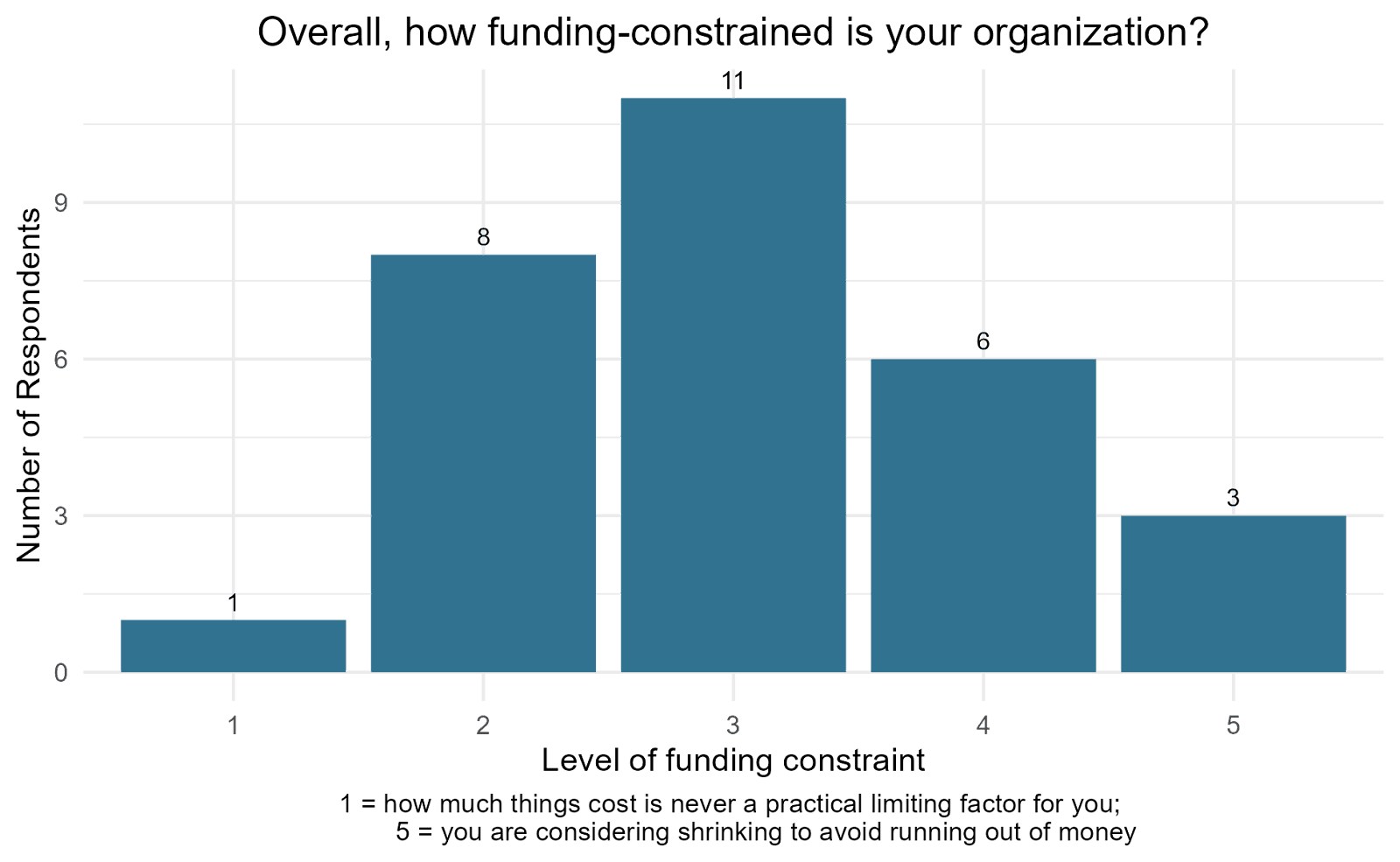
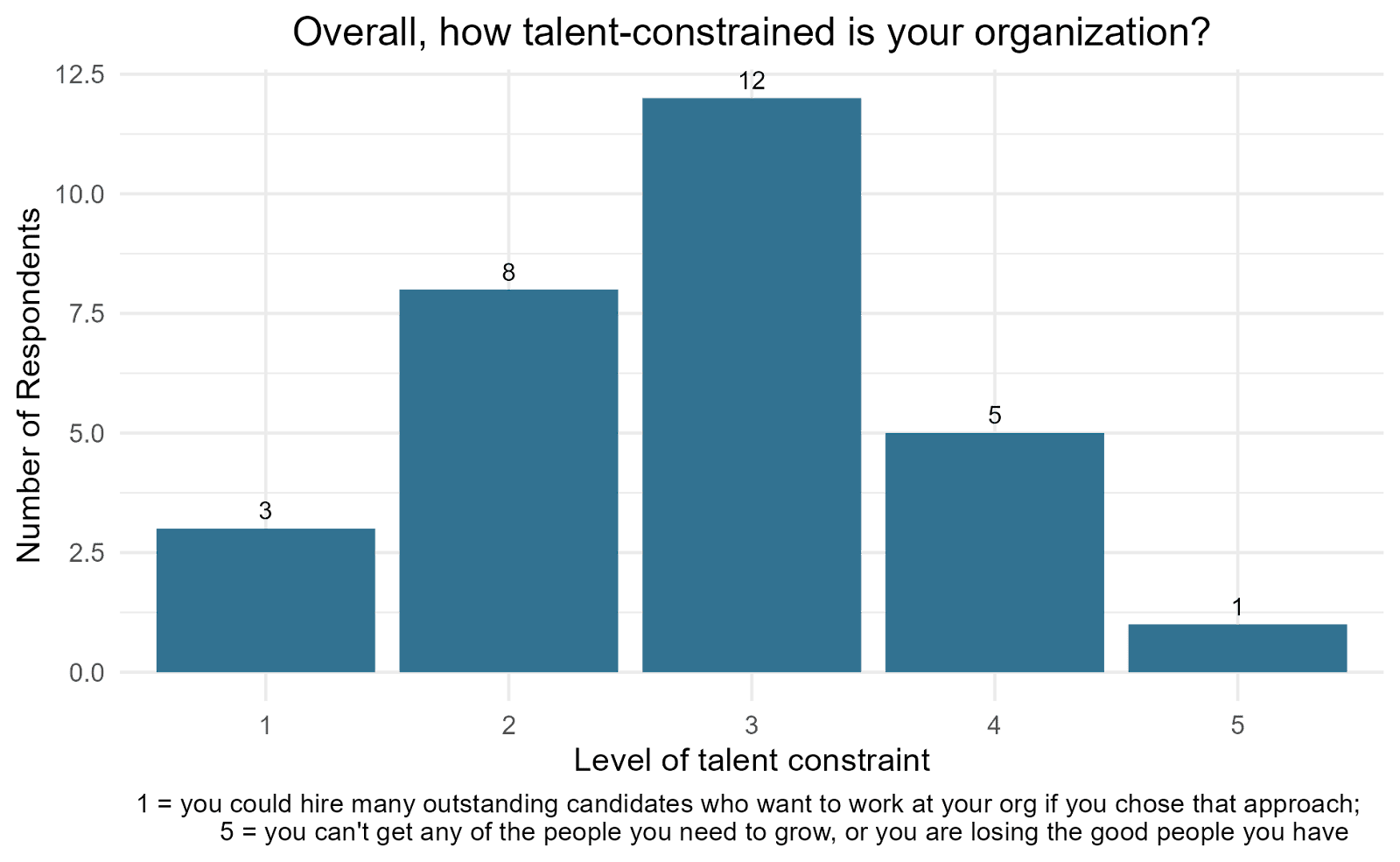

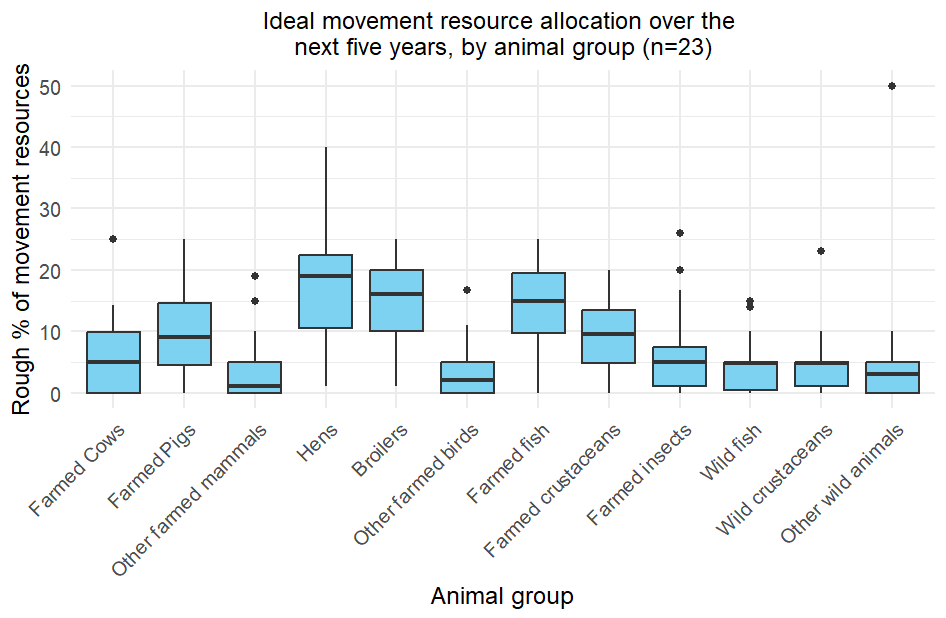
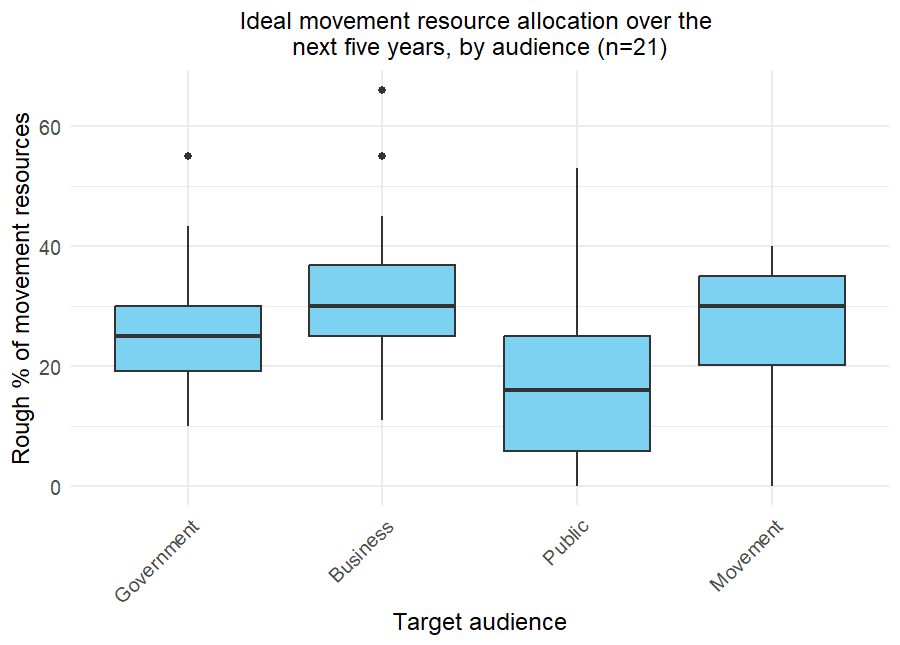
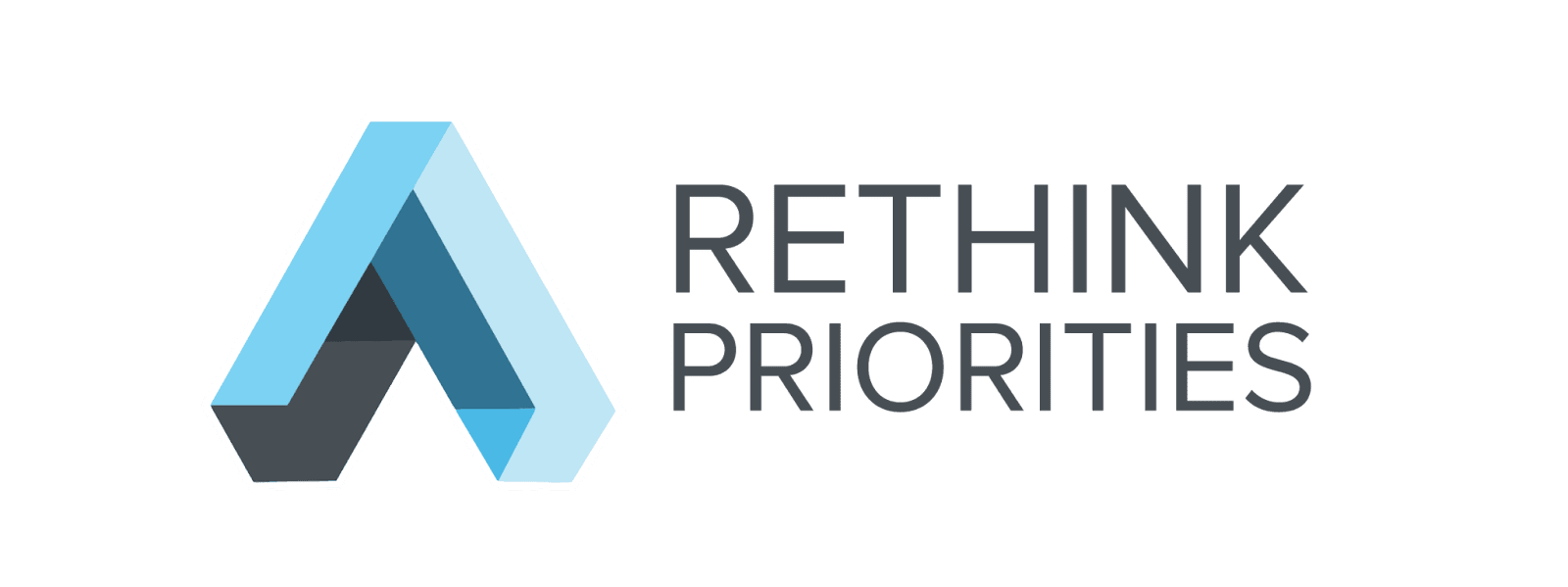
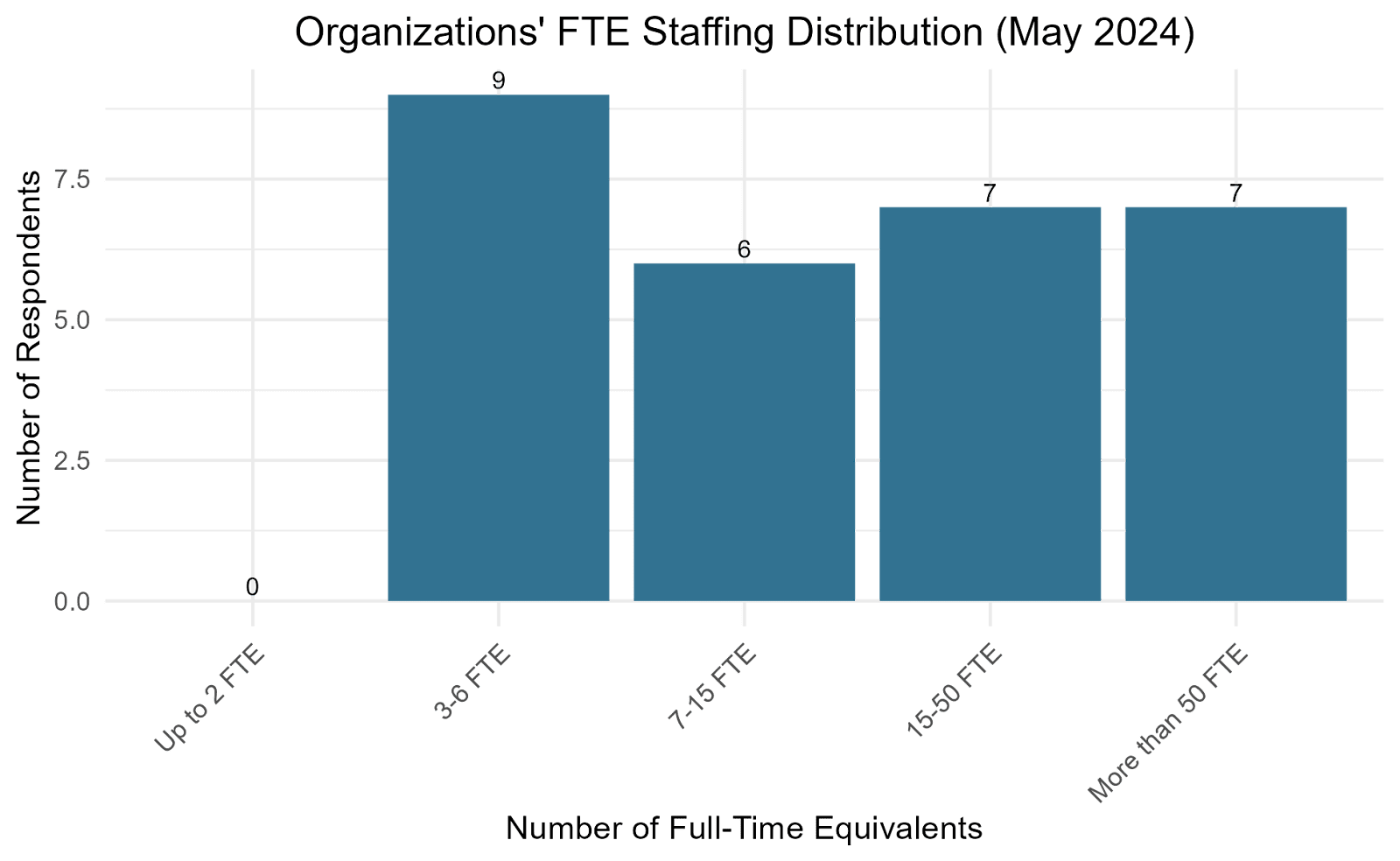

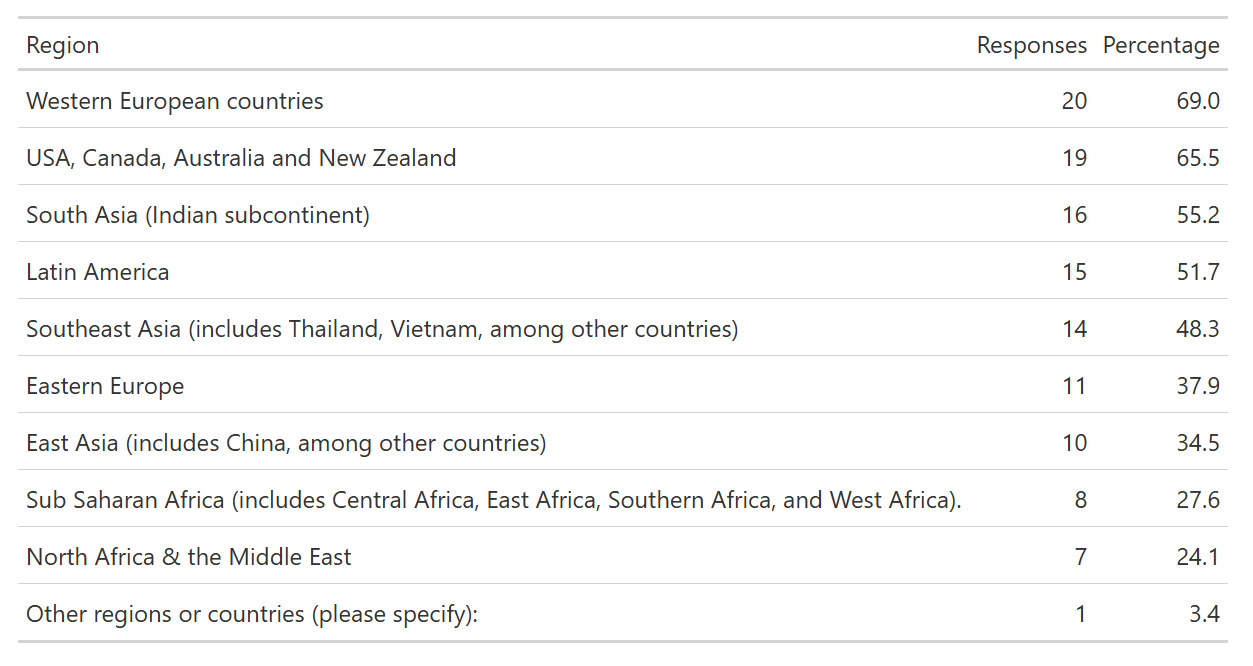
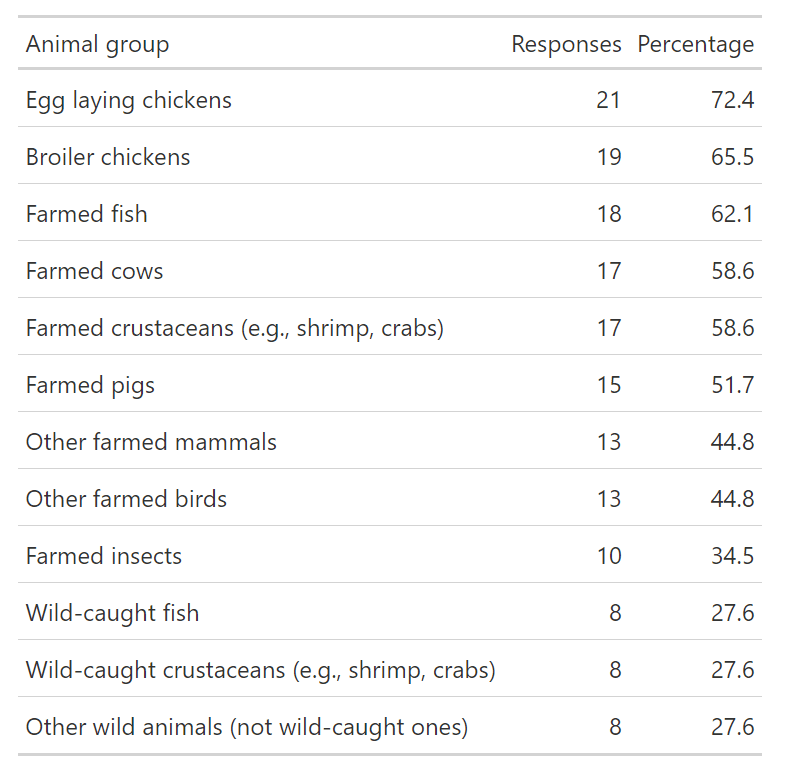
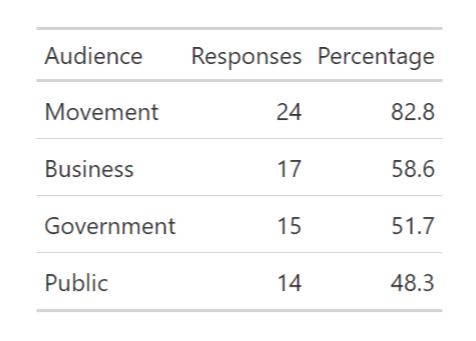
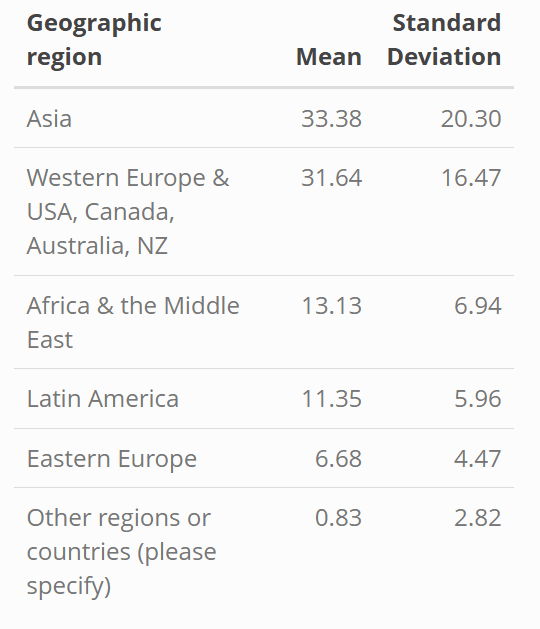
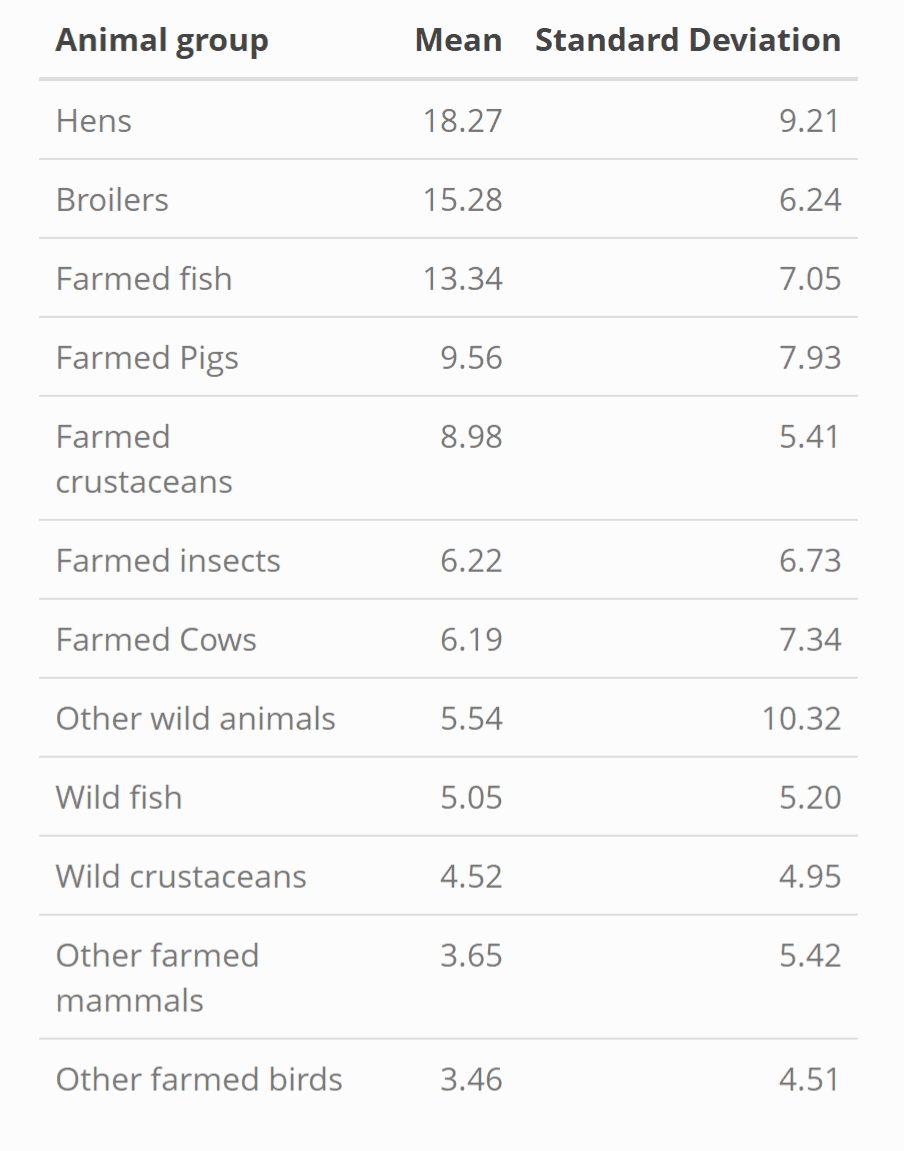

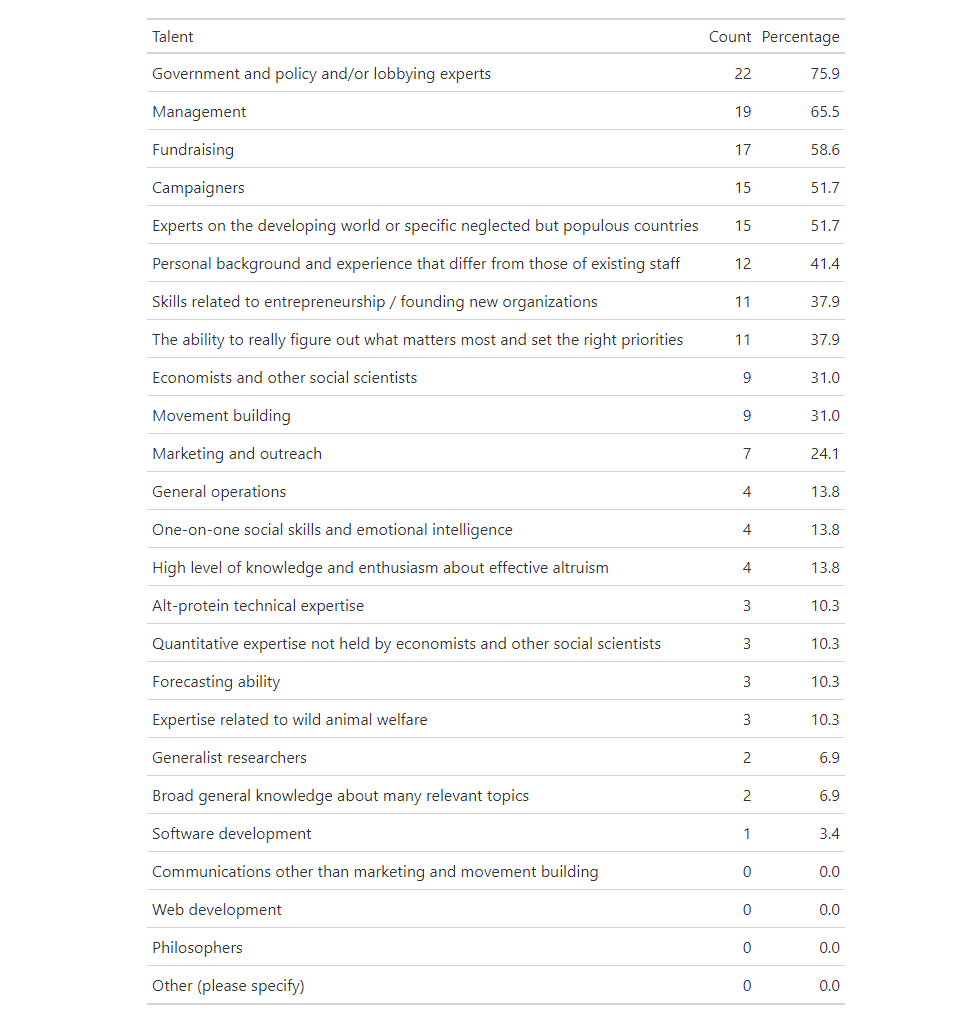
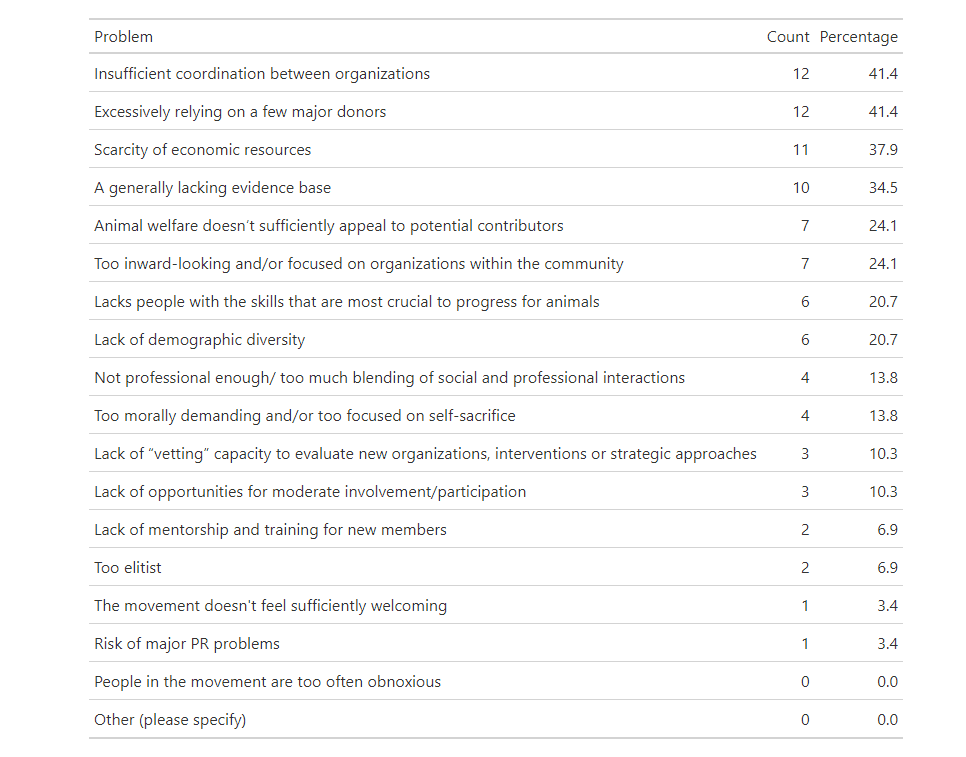
Very interesting - thanks for the write-up! Any chance you could share the following information on what these five projects actually are? Feel free to DM if imporant to keep private.
Thanks James! Someone from our team will DM you shortly.
Hi @Kieran Greig and thank you for the excellent write-up! I would like to join James' request, would that be possible? If not, no problem. Thank you!
For sure! :)
Executive summary: The 2024 Animal Advocacy Strategy Forum revealed key challenges and strategic priorities for the animal advocacy movement, focusing on coordination, funding, regional resource allocation, and talent development.
Key points:
This comment was auto-generated by the EA Forum Team. Feel free to point out issues with this summary by replying to the comment, and contact us if you have feedback.